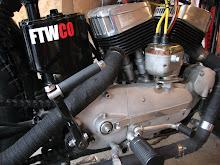Most of the time, the only occasion this tool is removed from the tool drawer is when there's a problem. Your camshaft, pinion gears, timer gear, breather gear . . . all the marks on the teeth line right up and your cam timing is done correctly? Right? Wrong? The fact is: You most likely have 4 to 5 parts, manufactured by 4 to 5 different manufacturers. A mark could be off a tooth? Throwing everything off . . . Different gear pitches. New parts meshing with used parts. Are your valves really opening and closing at the precise time they should?
This is the best way to do it. Using dial indicators. That needle will indicate movement (what the human eye can't see) You'll know exactly where you're at. It's best to check your valve movement directly off the valve itself (unless you have a 1:1 ratio like a knucklehead or 45, then the lifter is ok too). The clearances between the pushrod ends, rocker arm to valve, all take up space. Correcting cam timing is done by moving the cam gear on the camshaft (not easy). Also done by changing pinion gears, changing cam gears, moving the cam (+ or -) 1 or 2 teeth . . . or modifying keys and ways. It's a learning experience every time this tool comes out. Think about it....You did all this work and research choosing the perfect cam for your rebuild - but usually this step gets skipped. You don't have any idea if your aftermarket cam is doing what you want, unless you take the time and check your cam timing. It's one reason some engines just run better than others.
(pic of degree wheel on engine from: Lee (Lee's Speed Shop)

















1 comment:
Once upon a time I purchased a brand new Andrews B cam and put it in my Shovelhead. No increase in power or RPM... After I tried about EVERYTHING else, I degreed the cam... It was retarded 11*....They pressed the gear on wrong... Then I switched to a new C cam and made sure it was timed correctly... 43 hp with the B cam... 62 hp with the C cam...Rear wheel, dyno tested..
Post a Comment